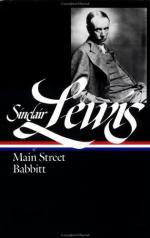“For an hour, in Minneapolis, I must have been near Erik. He’s still there, somewhere. He’ll be gone when I come back. I’ll never know where he has gone.”
As Kennicott switched on the seat-light she turned drearily to the illustrations in a motion-picture magazine.
CHAPTER XXXIV
They journeyed for three and a half months. They saw the Grand Canyon, the adobe walls of Sante Fe and, in a drive from El Paso into Mexico, their first foreign land. They jogged from San Diego and La Jolla to Los Angeles, Pasadena, Riverside, through towns with bell-towered missions and orange-groves; they viewed Monterey and San Francisco and a forest of sequoias. They bathed in the surf and climbed foothills and danced, they saw a polo game and the making of motion-pictures, they sent one hundred and seventeen souvenir post-cards to Gopher Prairie, and once, on a dune by a foggy sea when she was walking alone, Carol found an artist, and he looked up at her and said, “Too damned wet to paint; sit down and talk,” and so for ten minutes she lived in a romantic novel.
Her only struggle was in coaxing Kennicott not to spend all his time with the tourists from the ten thousand other Gopher Prairies. In winter, California is full of people from Iowa and Nebraska, Ohio and Oklahoma, who, having traveled thousands of miles from their familiar villages, hasten to secure an illusion of not having left them. They hunt for people from their own states to stand between them and the shame of naked mountains; they talk steadily, in Pullmans, on hotel porches, at cafeterias and motion-picture shows, about the motors and crops and county politics back home. Kennicott discussed land-prices with them, he went into the merits of the several sorts of motor cars with them, he was intimate with train porters, and he insisted on seeing the Luke Dawsons at their flimsy bungalow in Pasadena, where Luke sat and yearned to go back and make some more money. But Kennicott gave promise of learning to play. He shouted in the pool at the Coronado, and he spoke of (though he did nothing more radical than speak of) buying evening-clothes. Carol was touched by his efforts to enjoy picture galleries, and the dogged way in which he accumulated dates and dimensions when they followed monkish guides through missions.
She felt strong. Whenever she was restless she dodged her thoughts by the familiar vagabond fallacy of running away from them, of moving on to a new place, and thus she persuaded herself that she was tranquil. In March she willingly agreed with Kennicott that it was time to go home. She was longing for Hugh.
They left Monterey on April first, on a day of high blue skies and poppies and a summer sea.
As the train struck in among the hills she resolved, “I’m going to love the fine Will Kennicott quality that there is in Gopher Prairie. The nobility of good sense. It will be sweet to see Vida and Guy and the Clarks. And I’m going to see my baby! All the words he’ll be able to say now! It’s a new start. Everything will be different!”




